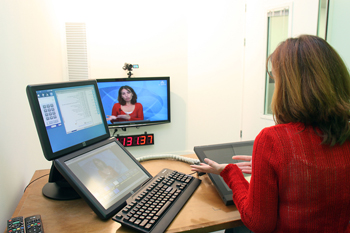| Previous issues | Subscribe |
| STUDENTS & GRADUATES |
|---|
|
|
|
|
|
|
|
|
| TECHNOLOGY |
|---|
|
|
|
|
| INITIATIVES - LANGUAGE |
|---|
| INTERNATIONAL |
|---|
| HIGHLIGHTS |
|---|
|
|
|
|
|
|
|
|
|
|
|
|
|
|
|
Co-editors: Elissa Allerhand, Ilene Bloch-Levy Photographer: Gideon Markowitz Graphic Designer: Laura Grinberg Web Manager: Batsheva Engelberg-Behr Web Master: Sonia Pechersky |
| RESEARCH |
|---|
Video Screening for ADD
For the past two years, Dr. Tal Hassner, Senior Faculty Member of the Open University's Department of Computer Sciences, has been doing statistical analyses on reams of data he has pulled from the University's tens of thousands of records on how students view online videos of courses. And, he has discovered that his team's analyses – "we're actually looking at old data in a new way" – provides a new way for objective, unobtrusive, accurate long-term screening for ADD (Attention Deficit Disorder) and other learning disabilities. A provisional patent has been filed and the research team, headed up by Dr. Hassner and including Dr. Anat Lerner,of the Computer Science Department of the Open University, Prof. Lior Wolf and Yael Leitner, psychologist at the Sorousky Medical Center in Tel Aviv continue their research. The Open University – A Perfect Testing GroundOne of the key problems neurologists face is that in researching neurological problems they have few available means for collecting empirical or objective data outside the clinic on how patients go about their daily lives. What they do have are "interviews, standardized tests and performance markers, such as grades, medical records, days off from work. Ideally," Dr. Hassner explains, "what you need to provide objective data in a natural setting would be a neurologist or other professional sitting on your shoulder and unobtrusively collecting numerical data outside of the controlled laboratory situation."What Dr. Hassner and his team believed was that individuals with various neurological issues watch videos differently than their counterparts. The Open University turned out to be a perfect testing ground for the team's theory. As the leading institute in Israel in distance teaching, thousands of students log on to the University's website and watch a pre-recorded lesson which is streamed over from the University's Shoham Center. The server routinely reports on what the student is watching, for what period of time, how often and for how long was pause pressed, etc. This information is retained for lengthy periods of time. Dr. Hassner's team looked at the viewing habits of some 9,000 individuals – a statistically significant large group. "Originally we took the group of 30,000 viewers, but narrowed it down to people who looked at more than 10 videos, so we eventually dropped down to 9,000 people." The Results: Surprisingly AccuratePrior to the outset, the team asked themselves a number of guiding questions:
"When we looked at who has ADD/ADHD (N.B. they had records on this from the outset) it came out to 480 people" Dr. Hassner explains, "which came to 5.3% which is the prevailing average in the general population (statistical ranges are 4-7%)."
Page: 1 2
|
